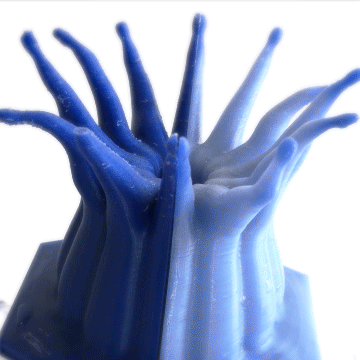- ABOUT US
- PROGRAM AREAS
- CONSERVATION APPROACH
- EDUCATION
- MULTIMEDIA
- Model printed at 50% scale (ideal)
- Layer height: 0.1 mm
- Infil: 20%
- Perimeter:
- Base: 1.2 mm
- Polyp tentacle tips: 2 mm
- Supports: off
- Print speed: 60mm/s
3D Printed Model Brings Coral Education to Life

This 3D coral polyp model shows a cross section of a single polyp, including its tentacles, gastrodermis, stomach cavity, and the complex skeletal structure underneath. It is a generic representation and not a replica of any particular species. Each half has interlocking pegs that allow a full polyp to be assembled.
Use a dual-spool 3D printer, if available, with white filament for the base (skeletal structure) and thermo-sensitive filament for the top polyp portion. For the best effect, use a filament that turns from color to white. When exposed to warm water, the polyp will then mimic the loss of its symbiotic zooxanthellae algae within and turn white. When the material cools down a few seconds later, the original color returns, signaling the restart of its symbiont algae and the return of the coral to a healthy state.
In addition, small pieces of material can be “fed” to the coral polyp through its “mouth” to symbolize the coral feeding in plankton.
3D Coral Polyp Model:
Coral Polyp Top (3 MB)
Coral Polyp Base (13 MB)
3D Print Specifications: The model file has two separate components—the polyp body and the skeletal base structure, which can be printed using two different filament materials (if available). The suggested 3D printer settings are
Education Video
Watch this video for a short demonstration of how the finished 3D coral polyp works, including brief introductions to basic coral biology and bleaching and how the model can be used to teach about coral bleaching and for general outreach purposes.
About Us

The NOAA Coral Reef Conservation Program was established in 2000 by the Coral Reef Conservation Act. Headquartered in Silver Spring, Maryland, the program is part of NOAA's Office for Coastal Management.

The Coral Reef Information System (CoRIS) is the program's information portal that provides access to NOAA coral reef data and products.
Work With US
U.S. Coral Reef Task Force
Funding Opportunities
Employment
Fellowship Program
Contracting Assistance
Graphic Identifier
Featured Stories Archive

Access the archive of featured stories here...
Feedback
Thank you for visiting NOAA’s Coral Reef Conservation Program online. Please take our website satisfaction survey. We welcome your ideas, comments, and feedback. Questions? Email coralreef@noaa.gov.
Stay Connected
Contact Us
NOAA’s Coral Reef Conservation Program
SSMC4, 10th Floor
1305 East West Highway
Silver Spring, MD 20910
coralreef@noaa.gov
